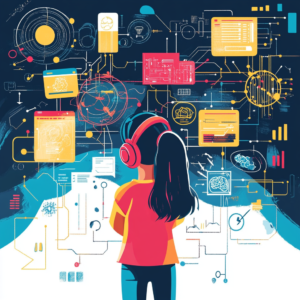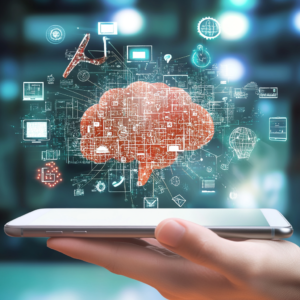Introduction
In this comprehensive guide on eLearning Trends 2025, I explore 10 innovative digital education trends that are revolutionizing how we teach and learn. The rapid evolution of technology offers endless opportunities for personalized learning, immersive experiences, and adaptive teaching methods. Embracing eLearning Trends 2025 can transform educational institutions, corporate training, and lifelong learning by integrating breakthrough innovations such as artificial intelligence, virtual reality, microlearning, and adaptive learning systems. These trends pave the way for a more flexible, efficient, and inclusive educational environment. Before diving in, please check out How to Choose the Best Online Learning Platform for Your Needs and consider subscribing to our newsletter for ongoing insights.

Overview
This guide provides detailed explanations, real-world examples, and practical strategies for integrating these transformative trends into your educational practices. Each section is enriched with in-depth insights to help you understand the impact of these innovations and how to leverage them effectively.
Trend 1: AI-Powered Personalized Learning – eLearning Trends 2025
Artificial intelligence is at the forefront of educational innovation, offering a transformative approach to personalized learning. By harnessing AI, educators can analyze student performance data, learning styles, and engagement metrics to create tailored educational pathways.
How It Works
AI-powered systems integrate machine learning algorithms that process vast amounts of student data. These systems identify patterns and predict learning challenges, allowing the content to be adjusted in real time. As a result, each learner receives customized instruction that adapts to their progress.
Real-World Examples
Many modern eLearning platforms now utilize AI to recommend additional resources, adjust difficulty, and even forecast potential gaps in understanding. Institutions that have implemented these systems report improved test scores and higher student satisfaction. This technology also reduces the workload for educators by automating tasks such as grading and providing feedback.
In-Depth Insights
The benefits of AI extend beyond personalization. Advanced analytics provide educators with actionable insights that help in curriculum development and resource allocation. This means that AI is not just a tool for individual learning but also an essential component for broader educational strategy. The scalability of AI ensures that even large classes can receive tailored learning experiences without compromising quality. To learn more about the role of artificial intelligence in education, visit How AI is Revolutionizing Online Education and eLearning. Embracing AI is a core aspect of eLearning Trends 2025 and is essential for staying competitive in today’s digital era.
Trend 2: Immersive Virtual and Augmented Reality Experiences
Virtual reality (VR) and augmented reality (AR) are transforming traditional education by creating immersive, interactive environments. These technologies enable students to engage with content in ways that traditional methods cannot match.
Overview of Immersive Technologies
VR headsets and AR applications allow learners to step into digital worlds where abstract concepts become tangible. For instance, a history class can virtually transport students to ancient civilizations, while a science course can let them interact with 3D molecular models. These experiences deepen understanding and retention by engaging multiple senses.
Impact on Learning
Research shows that immersive learning experiences can boost information recall significantly. When students actively participate in a simulated environment, they are more likely to retain and apply what they learn. The interactivity of VR and AR also encourages collaborative learning, as virtual classrooms enable students from different locations to interact in real time.
In-Depth Insights
Integrating immersive technology into curricula also opens up new opportunities for interdisciplinary learning. For example, VR can be used in both art and science courses to demonstrate the intersection of creativity and technology. Additionally, these technologies can be customized to fit various subjects, ensuring that the learning experience is both engaging and contextually relevant. For more insights into creating immersive digital learning experiences, see How to Create a Compelling eLearning Website That Converts and watch this video on immersive learning at Watch on YouTube.
For those interested in learning a new language in a fun and practical way, I recommend this course to expand your knowledge.
Trend 3: Microlearning and Bite-Sized Content
Microlearning delivers concise, focused segments of content that fit into busy schedules without overwhelming learners. This method breaks down complex subjects into manageable modules, making learning more efficient.
Advantages of Microlearning
Short lessons allow for just-in-time learning, enabling learners to absorb information quickly and apply it immediately. This is especially effective in corporate training, where employees need to learn new skills rapidly. Microlearning also offers the flexibility to update individual modules as needed, ensuring that the material remains current.
Implementation Examples
Instead of a lengthy lecture, learners can engage with several 5- to 10-minute segments that target specific topics. This modular approach not only enhances retention but also allows for periodic assessments to reinforce learning. Many organizations have successfully implemented microlearning to boost productivity and performance.
In-Depth Insights
The modularity of microlearning lends itself to various digital formats, including videos, interactive quizzes, and podcasts. This versatility makes it an ideal solution for diverse learning environments. By leveraging microlearning, educators can create a more engaging curriculum that adapts to the fast pace of modern life. For practical guidance on crafting compelling microlearning experiences, read Essential Tools for Creating Engaging Online Courses. Integrating microlearning is a vital part of eLearning Trends 2025.
Trend 4: Gamification in Education
Gamification involves applying game-design elements to education, transforming learning into an interactive and motivating experience. This strategy uses rewards, challenges, and competition to engage students.
Benefits of Gamification
By introducing game-like elements such as points, badges, and leaderboards, educators can incentivize student participation and create a fun learning environment. Immediate feedback and measurable progress keep learners motivated and help them track their achievements over time.
Practical Application
Language-learning platforms like Duolingo are prime examples of gamification in action. Such platforms reward users for consistent practice and challenge them with interactive tasks. The competitive aspect encourages continuous improvement and fosters a sense of accomplishment.
In-Depth Insights
Gamification not only drives engagement but also enhances retention by making abstract concepts more tangible through interactive challenges. Moreover, it promotes collaboration when learners participate in team-based competitions. The use of gamification can be tailored to various educational contexts, from elementary schools to professional training programs. For more insights into effective gamification strategies, visit Online Teaching Best Practices. This method is a cornerstone of eLearning Trends 2025, turning education into an enjoyable, reward-based journey.
Trend 5: Mobile Learning Revolution – eLearning Trends 2025
The widespread adoption of smartphones and tablets has led to the rise of mobile learning. This trend breaks the traditional boundaries of the classroom, making education accessible anytime and anywhere.
Key Features of Mobile Learning
Mobile learning leverages the portability of digital devices to deliver content in real time. Learners can access courses, participate in discussions, and receive immediate feedback through apps and responsive websites. This constant connectivity ensures that education becomes a seamless part of everyday life.
Impact on Modern Education
The flexibility provided by mobile learning means that students no longer need to be confined to a classroom to learn effectively. Instead, learning becomes an ongoing process, available during commutes or even during short breaks. This adaptability is particularly beneficial for remote learners and professionals balancing multiple responsibilities.
In-Depth Insights
Mobile learning also democratizes access to education, allowing individuals in underserved areas to connect with high-quality learning resources. With support for various media types, including video, interactive simulations, and quizzes, mobile learning creates a richer, more engaging educational experience. For additional insights on the impact of mobile learning, check out The Impact of Mobile Learning: Trends and Opportunities.

Trend 6: Data-Driven Learning Analytics
Data-driven learning analytics is revolutionizing the education sector by offering insights into student performance, behavior, and engagement. Through systematic data collection, educators can fine-tune their instructional strategies and better support their students.
How Analytics Improve Learning
By monitoring metrics such as quiz scores, time on task, and participation rates, educators can identify strengths and weaknesses in their curriculum. This ongoing analysis helps in adjusting teaching methods and materials to better align with student needs, leading to improved outcomes.
Benefits in Practice
For example, if analytics indicate that a particular module is causing widespread difficulties, educators can intervene by providing additional resources or reworking the content. This data-driven approach not only improves individual performance but also enhances overall curriculum effectiveness. To learn more about leveraging data in education, visit Using Data Analytics to Improve eLearning Outcomes.
In-Depth Insights
Beyond individual classrooms, data analytics can inform institutional strategies, from curriculum design to long-term planning. The insights gained can lead to significant improvements in student engagement and learning efficiency, making analytics an essential component of modern education.
Trend 7: Social Learning and Collaborative Platforms – eLearning Trends 2025
Social learning leverages the power of collaboration and community to enhance the educational experience. In today’s interconnected world, incorporating social elements into learning platforms fosters interaction, idea sharing, and mutual support among students.
Importance of Social Interaction
Digital tools such as discussion forums, group projects, and live webinars create a dynamic environment where learners can connect and collaborate. This interaction not only deepens understanding but also builds essential communication and teamwork skills.
Building Community
When students engage with their peers, they gain diverse perspectives that enrich the learning process. For effective strategies on fostering social learning, see Building a Community Around Your Online Courses.
In-Depth Insights
Social learning also combats the isolation that can sometimes occur in online education, providing a supportive network that enhances motivation and persistence. This collaborative model is a critical element of eLearning Trends 2025 and has the potential to transform the way educational communities operate.
Trend 8: Blockchain for Credentialing and Certification
Blockchain technology is emerging as a secure and transparent method for verifying academic credentials. In an era of increasing digital fraud, blockchain provides an immutable record of academic achievements that can be trusted by employers and institutions alike.
The Role of Blockchain in Education
Blockchain creates a decentralized ledger that ensures certificates and diplomas are tamper-proof. This added layer of security streamlines the verification process and reduces the administrative burden on institutions.
Practical Implications
The adoption of blockchain can lead to significant improvements in the transparency and efficiency of academic credentialing. Educational institutions that implement blockchain not only enhance trust but also simplify the process for verifying qualifications. For more on this disruptive innovation, read How Blockchain is Disrupting Traditional Education Models.
In-Depth Insights
As blockchain technology evolves, its applications in education will likely expand to include tracking continuing education credits and facilitating international recognition of qualifications. This innovation is set to become a fundamental component of eLearning Trends 2025.
Trend 9: Adaptive Learning Technologies – eLearning Trends 2025
Adaptive learning technologies are designed to adjust educational content in real time based on individual student performance. These systems continuously assess progress and modify instruction to ensure that each learner receives the appropriate level of challenge and support.
Personalized Learning Through Adaptation
Adaptive systems use real-time data to determine which areas a student has mastered and which require further reinforcement. This personalized approach not only accelerates learning but also enhances overall retention.
Measuring Impact and Effectiveness
Educators can monitor the success of adaptive learning through various performance metrics and feedback loops. These systems provide a dynamic learning experience that evolves with the student’s progress. For detailed insights on adaptive learning, visit 7 Key Metrics Every eLearning Platform Should Track.
In-Depth Insights
The effectiveness of adaptive learning lies in its ability to offer a customized educational journey for every student. This approach ensures that learners are neither bored with content that is too easy nor overwhelmed by material that is too challenging. As a result, adaptive learning is a cornerstone of eLearning Trends 2025.

Trend 10: Hybrid and Blended Learning Models – eLearning Trends 2025
Hybrid and blended learning models combine the strengths of traditional classroom instruction with the flexibility of online education. This balanced approach maximizes student engagement while efficiently utilizing available resources.
Defining Hybrid and Blended Models
In a hybrid learning model, some lessons are delivered face-to-face while others are conducted online, offering both personal interaction and digital convenience. Blended learning takes this a step further by seamlessly integrating digital tools into the classroom experience, ensuring that different learning styles are accommodated.
Advantages and Implementation
These models have proven particularly effective in modern educational settings, enabling flexible scheduling and personalized instruction. They allow educators to combine the best aspects of both digital and traditional methods, creating a more robust learning environment. For a comprehensive guide on implementing these models, read Step-by-Step Guide to Launching Your eLearning Business.
In-Depth Insights
Hybrid and blended learning are not merely temporary solutions but represent a paradigm shift in education. By merging traditional and digital methods, these models provide a resilient framework that can adapt to changing circumstances. They are especially valuable during times when access to physical classrooms is limited, ensuring continuity in education. This innovative approach is a vital component of eLearning Trends 2025.
For those looking to invest in professional courses to enter the job market, this course is a good option.
Conclusion
As we look to the future, embracing transformative innovations is essential for reshaping education. By integrating advanced technologies such as AI-powered personalized learning, immersive VR and AR experiences, microlearning, gamification, mobile learning, data analytics, social learning, blockchain for credentialing, adaptive learning, and hybrid models, educators can create dynamic, engaging, and personalized learning environments. These strategies, which together define eLearning Trends 2025, not only enhance the learning experience but also equip students with the skills necessary for success in a rapidly evolving digital world.
Final Thoughts
Institutions and educators that adopt these innovations contribute to a more inclusive and efficient educational landscape. Continuous adaptation and investment in new technologies ensure the quality and accessibility of education for future generations. For more strategies on effective online teaching and digital marketing, visit Marketing Strategies for Your Online Course.
FAQ
Q1: What is AI-powered personalized learning and how does it benefit students?
A1: AI-powered personalized learning tailors content to individual needs by analyzing data and performance, helping students overcome learning gaps and progress more efficiently.
Q2: How do VR and AR enhance the educational experience?
A2: VR and AR create immersive, interactive environments that enable learners to explore content in ways not possible with traditional methods, significantly boosting engagement and retention.
Q3: Why is microlearning considered effective in modern education?
A3: Microlearning delivers concise, targeted lessons that fit busy schedules, improving retention and engagement by providing just-in-time learning opportunities.
Q4: How does gamification improve student engagement?
A4: Gamification introduces game-like elements that motivate students through immediate feedback and rewards, making the learning process both fun and interactive.
Q5: In what ways do adaptive learning technologies contribute to personalized education?
A5: Adaptive learning systems adjust educational content in real time based on student performance, ensuring each learner receives a customized learning experience that enhances understanding.
